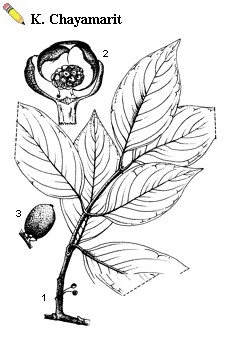Record Number
1404
PROSEA Handbook Number
3: Dye and tannin-producing plants
Taxon
Garcinia hanburyi Hook.f.
Protologue
Journ. Linn. Soc. Lond. 14: 485 (1875).
Family
GUTTIFERAE
Chromosome Numbers
2n = 44
Synonyms
Garcinia morella Desr. var. pedicellata Hanbury (1864).
Vernacular Names
Gamboge tree (En). Cambodia: rung. Thailand: rong. Vietnam: vàng nghê, dang hoàng.
Origin and Geographic Distribution
Gamboge tree is a native of Cambodia, southern Vietnam and Thailand. It has been introduced in Singapore.
Uses
This tree is valued because of the resinous sap, called gamboge, which exudes from incisions in the bark. This sap is used as a golden-yellow colouring matter for varnishes, lacquer, paints, and ink.
Gamboge is a drastic purgative, an emetic, and a vermifuge for treating tapeworm, but it is no longer used in human medicine. Sometimes it is given to cows as purgative.
The wood is sometimes used for interior work.
Gamboge is a drastic purgative, an emetic, and a vermifuge for treating tapeworm, but it is no longer used in human medicine. Sometimes it is given to cows as purgative.
The wood is sometimes used for interior work.
Properties
The reddish-yellow to brownish-orange sap contains 70—80% resin and 15—25% gum. The main acidic component of the resin is cambogic acid (C38H44O8). The main components of the gum are arabinose (ca. 50%), and galactose (ca. 40%); the gum is soluble in water and forms a yellow emulsion in water. Gamboge is odourless and tasteless or slightly acid. Large doses of gamboge, administered as a medicine, can be fatal.
The wood is pale or brownish-yellow, straight grained, with fine texture, and fairly heavy, weighing about 900 kg/m3. It is moderately hard and works easily; it takes a fine polish.
The wood is pale or brownish-yellow, straight grained, with fine texture, and fairly heavy, weighing about 900 kg/m3. It is moderately hard and works easily; it takes a fine polish.
Botany
An evergreen, small to medium-sized tree, up to 15 m tall, with short and straight trunk, up to 20 cm in diameter; bark grey, smooth, 4—6 mm thick, exuding a yellow gum-resin. Leaves opposite, leathery, elliptic or ovate-lanceolate, 10—25 cm x 3—10 cm, cuneate at base, acuminate at apex, shortly stalked. Flowers in clusters or solitary in the axils of fallen leaves, 4-merous, pale yellow and fragrant, unisexual or bisexual; male flowers somewhat smaller than female and bisexual; sepals leathery, orbicular, 4—6 mm long, persistent; petals ovate, 6—7 mm long; stamens numerous and arranged on an elevated receptacle in male flowers, less numerous and reduced in female flowers; ovary superior, 4-loculed, with sessile stigma. Fruit a globose berry, 2—3 cm in diameter, smooth, with recurved sepals at the base and crowned by the persistent stigma, 1—4-seeded. Seeds 15—20 mm long, surrounded by a pulpy aril.
The gum-resin from Garcinia hanburyi is often called Siamese gamboge to distinguish it from the similar product from the bark of Garcinia morella Desr., called Indian gamboge. The species are closely related, and Garcinia hanburyi has been considered in the past as a variety of Garcinia morella.
The gum-resin from Garcinia hanburyi is often called Siamese gamboge to distinguish it from the similar product from the bark of Garcinia morella Desr., called Indian gamboge. The species are closely related, and Garcinia hanburyi has been considered in the past as a variety of Garcinia morella.
Image
 | Garcinia hanburyi Hook.f. - 1, flowering branch; 2, male flower with front sepal and petals removed; 3, fruit |
Ecology
Gamboge tree occurs naturally in rain forest on altitudes up to 800 m, with annual rainfall up to 2500 mm. Normally it flowers in November and December and fruits from February to April.
Harvesting
Gamboge tree is not in cultivation; only wild trees are tapped. Usually trees are not tapped before they are 20 years old, when the trunk has attained a diameter of about 15 cm. A spiral incision is made in the trunk just below the lowest branches, and the exudate is collected in a bamboo container. About every 3 days the content is poured into smaller bamboo stem parts (about 75 cm long), in which the gum-resin coagulates in about a month or longer. The bamboo containers are then cracked and the gamboge is removed in cylindrical sticks (pipe gamboge), which is the usual form in trade. Sometimes gamboge is moulded and pressed into cakes.
Prospects
In Singapore, gamboge tree has been planted successfully. It has never been tried elsewhere in Malesia. As it is apparently well-suited to a moist climate, it is a promising tree for the production of dyeing material and lacquer.
Literature
Anonymous, 1895. Siam gamboge. Kew Bulletin (1895): 139—140.
Crevost, Ch., 1927. Catalogue des produits de l'Indochine. Tome 4. Exsudats végétaux—stick-lac. Gouvernement général de l'Indochine, Hanoi. pp. 80—85 + fig.
Perry, L.M., 1980. Medicinal plants of East and Southeast Asia. Massachusetts Institute of Technology Press, Cambridge, Massachusetts, USA. p. 174.
Sastri, B.N. (Editor), 1956. The wealth of India. Raw materials. Vol. 4. Council of Scientific and Industrial Research, New Delhi, India. p. 106.
Crevost, Ch., 1927. Catalogue des produits de l'Indochine. Tome 4. Exsudats végétaux—stick-lac. Gouvernement général de l'Indochine, Hanoi. pp. 80—85 + fig.
Perry, L.M., 1980. Medicinal plants of East and Southeast Asia. Massachusetts Institute of Technology Press, Cambridge, Massachusetts, USA. p. 174.
Sastri, B.N. (Editor), 1956. The wealth of India. Raw materials. Vol. 4. Council of Scientific and Industrial Research, New Delhi, India. p. 106.
Author(s)
K. Chayamarit
Correct Citation of this Article
Chayamarit, K., 1991. Garcinia hanburyi Hook.f.. In: Lemmens, R.H.M.J. and Wulijarni-Soetjipto, N. (Editors): Plant Resources of South-East Asia No 3: Dye and tannin-producing plants. PROSEA Foundation, Bogor, Indonesia. Database record: prota4u.org/prosea

All texts are licensed under a Creative Commons Attribution-Noncommercial-Share Alike 3.0 Netherlands License
This license does not include the illustrations (Maps,drawings,pictures); these remain all under copyright.